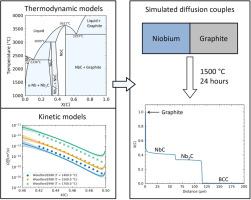C-Nb、C-U和Nb-U体系中BCC和碳化物相的迁移率评价
IF 3.2
2区 工程技术
Q3 MATERIALS SCIENCE, MULTIDISCIPLINARY
引用次数: 0
摘要
添加难熔金属的碳化铀因其高温耐腐蚀性能被考虑用于第四代核反应堆和核热推进装置。了解在制造和操作条件下决定微观结构演变的动力学效应对于推进这些燃料的技术发展至关重要。本工作介绍了基于ab-initio方法支持的可用实验数据的C-Nb-U系统原子迁移率数据库的开发。在Kawin软件中进行了机动性评估和不确定性量化(利用马尔科夫链蒙特卡罗)。碳扩散被认为是主要的,因为金属扩散要慢得多,铌的扩散甚至比铀金属更慢,而且速度有限。我们提供了一个全面和自一致的热动力学数据库,并通过Kawin进行了扩散耦合模拟。这使得能够预测对下一代核燃料的开发和寿命评估至关重要的微观结构和阶段演变。本文章由计算机程序翻译,如有差异,请以英文原文为准。

Mobility assessment of the BCC and carbide phases in the C-Nb, C-U and Nb-U systems
Uranium carbides with refractory metal additions are considered for Gen IV nuclear reactors and nuclear thermal propulsion as fuels for their high-temperature and corrosion resistant properties. Understanding kinetic effects that dictate microstructural evolution during fabrication and operating conditions is essential to advance technological development of these fuels. This work presents the development of an atomic mobility database for C-Nb-U systems based off available experimental data supported with ab-initio methods. The mobility assessments and uncertainty quantification (using Markov chain Monte Carlo) were conducted in the Kawin software. Carbon diffusion is considered dominant, as metal diffusion is much slower, with niobium diffusion being even slower and rate limiting than uranium metal. We provide a comprehensive and self-consistent thermo-kinetic database that is validated by diffusion couple simulations through Kawin. This enables prediction of microstructural and phase evolution critical for the development and lifetime assessment of next generation nuclear fuels.
求助全文
通过发布文献求助,成功后即可免费获取论文全文。
去求助
来源期刊

Journal of Nuclear Materials
工程技术-材料科学:综合
CiteScore
5.70
自引率
25.80%
发文量
601
审稿时长
63 days
期刊介绍:
The Journal of Nuclear Materials publishes high quality papers in materials research for nuclear applications, primarily fission reactors, fusion reactors, and similar environments including radiation areas of charged particle accelerators. Both original research and critical review papers covering experimental, theoretical, and computational aspects of either fundamental or applied nature are welcome.
The breadth of the field is such that a wide range of processes and properties in the field of materials science and engineering is of interest to the readership, spanning atom-scale processes, microstructures, thermodynamics, mechanical properties, physical properties, and corrosion, for example.
Topics covered by JNM
Fission reactor materials, including fuels, cladding, core structures, pressure vessels, coolant interactions with materials, moderator and control components, fission product behavior.
Materials aspects of the entire fuel cycle.
Materials aspects of the actinides and their compounds.
Performance of nuclear waste materials; materials aspects of the immobilization of wastes.
Fusion reactor materials, including first walls, blankets, insulators and magnets.
Neutron and charged particle radiation effects in materials, including defects, transmutations, microstructures, phase changes and macroscopic properties.
Interaction of plasmas, ion beams, electron beams and electromagnetic radiation with materials relevant to nuclear systems.
 求助内容:
求助内容: 应助结果提醒方式:
应助结果提醒方式:


